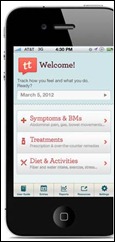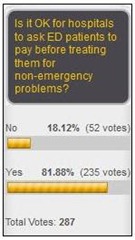Curbside Consult with Dr. Jayne 6/25/12
I maintain staff privileges at a hospital where I almost never admit. Even with my non-existent volume, I still have to attend training, so I wasn’t surprised a few months ago when I received the postcard saying that it was time to talk about finally going live on CPOE.
It’s kind of funny, because more than four years ago I served on the selection committee for this particular product. I remember at the time being shocked that we were even considering it because the user interface was so buggy at the hospital where we did our site visit. Meanwhile, I had moved on to greener CMIO pastures, but I still keep those privileges out of nostalgia (or maybe out of fear that one day I might have to go back into traditional practice.)
Luckily the final training blocks coincided with a couple of comp days I had already scheduled. I wrote about my recent Meaningful Use upgrade training a few months ago and I hoped that this would be a similar experience. However, I think I could use it to write a case study in how to alienate the medical staff.
Being a veteran trainer, I arrived 15 minutes early because I knew I’d have a logon / password issue since I rarely go to that facility. The training room was dark, so I poked my head into the room next door to make sure I was in the right place. The training team was sitting around and barely noticed me. In fact, they were talking about another physician – making fun of one who had arrived half an hour early because he was cutting into their break time. I pretended I didn’t hear them and asked if I was in the right place. I was told they’d be in the room shortly.
I went to the room and found a seat at a folding card table (no, I’m not kidding) with actual damp coffee on it. They finally walked in five minutes after training was supposed to start and began passing around a coffee-stained sign-in sheet for continuing medical education credit. That was a plus – I hadn’t expected to receive hours and it’s always good to have some “live” credit since I do most of my CME online. But the coffee was a turn-off.
Additionally, since the last time I rounded, the facility had gone to proximity badges. I didn’t have one, which created much hubbub, although none of the trainers could tell me who to talk to in order to get one. Surprisingly, my ancient logon and password were not expired.
After dealing with the sign-in sheet and the proximity badges (I wasn’t the only one without one – the other doc who had arrived 30 minutes early didn’t have one either) they finally decided to fire up the projector and went through a whole “how do I adjust the keystone” saga. My new Twitter BFF, @MeetingBoy, would have been proud.
Training finally started about 15 minutes late. To my chagrin, they not only accommodated late arrivals, but stopped class and rehashed everything that had been covered to that point.
I was given a cheat sheet with some patient names, one of whom was a 14-year-old male named “Samantha,” which added realism to the scenarios. The class moved at a glacial pace to allow for one of the more senior members of our class (whom I know to be at least 85 years old) to keep up. I felt so sorry for her – she is very sweet and is a fixture at the hospital, and they really should have offered her an individualized class.
About an hour and a half into the class, everyone was kicked out of the application. The trainers explained that the build team was still creating order sets and had a tendency of uploading their work several times a day “to keep the environment fresh.” I don’t know about you, but I’m pretty sure we didn’t need their recent (probably untested) build work to make it through class.
I was surprised to see that the version being deployed was the same version we looked at four years ago. I know this product didn’t make its vendor’s “go forward” list, but I’m pretty sure there’s been another release since then. I’m not sure about the rationale for taking outdated software into a live environment.
All the bugs and UI glitches that we had seen during selection were still there. Some orders were in alphabetical order when it would have made more sense to have them sorted by frequency of ordering or grouped by body system. Others were arranged by the order in which they were added to the database rather than being in alphabetical order. You could see what the “oops, forgot that one” tests were because they were at the bottoms of the lists. Seeing “do not use” abbreviations is always a treat as well. Several screens had such inconsistent use of color that it looked as if a bag of Skittles had been upended on the screen.
I was pleasingly surprised to see that the system had a button for logging bugs (really a glorified e-mail launch) and the other docs in the room got a kick out of that too. Docs were told to log anything they thought should be added and that it would be placed in the system. There was no mention of change control, governance, or peer review of the suggestions.
Laughs were had over the trainer’s warning that we shouldn’t try to use the embedded help files because the system had been customized so much that they weren’t relevant. The trainers took great pride in telling us how many hundreds of hours it took to build some screens vs. others and the hours quoted were really quite unreal.
Several common acronyms were used in the order sets, but unfortunately some elements were out of order and others were missing, making it hard to recognize the acronyms. With as many thousands of hours as were allegedly spent building, it didn’t appear that there was much clinical oversight. No surprise – the hospital in question does not have a CMIO and I’m not sure there were medical informatics experts involved in system planning and design either.
This was the fourth training session of the fourth week (only a few days prior to go live) and at least three of us noticed a major patient safety defect that had not yet been discovered. On some screens, patient demographic and vital signs data rounded up and/or down without reason. I’m not sure about you, but when a patient is documented as weighing 78 kg in the base clinical application, I don’t expect to see him rounded down to 70 kg in the CPOE module. Other areas of the system simply had garbage in the build (the ubiquitous ZZZZ added before pick list items to push them to the bottom) which always drives me crazy.
The doc seated next to me said she couldn’t believe we were forced to attend the class live. It could easily have been given as a 90-minute webinar instead. I didn’t disagree. I did receive two hours of continuing education credit for my four-hour tour, so it wasn’t a total loss.
The hospital went live on CPOE over the weekend. From what I hear, things went well, all things considered. I wish them the best, but hope the next rollout has not only better software but better training.
Have a training horror story? Does your system remind you of colorful candy? E-mail me.































You know what will radically improve patient lives? Universal healthcare, access to housing, paid childcare, better public transport. Improve a…